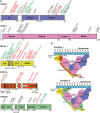VPS34 complexes from a structural perspective
- PMID: 30397185
- PMCID: PMC6358306
- DOI: 10.1194/jlr.R089490
VPS34 complexes from a structural perspective
Abstract
VPS34 phosphorylates phosphatidylinositol to produce PtdIns3P and is the progenitor of the phosphoinositide 3-kinase (PI3K) family. VPS34 has a simpler domain organization than class I PI3Ks, which belies the complexity of its quaternary organization, with the enzyme always functioning within larger assemblies. PtdIns3P recruits specific recognition modules that are common in protein-sorting pathways, such as autophagy and endocytic sorting. It is best characterized in two heterotetramers, complexes I and II. Complex I is composed of VPS34, VPS15, Beclin 1, and autophagy-related gene (ATG)14L, whereas complex II replaces ATG14L with UVRAG. Because VPS34 can form a component of several distinct complexes, it enables independent regulation of various pathways that are controlled by PtdIns3P. Complexes I and II are critical for early events in autophagy and endocytic sorting, respectively. Autophagy has a complex association with cancer. In early stages, it inhibits tumorigenesis, but in later stages, it acts as a survival factor for tumors. Recently, various disease-associated somatic mutations were found in genes encoding complex I and II subunits. Lipid kinase activities of the complexes are also influenced by posttranslational modifications (PTMs). Mapping PTMs and somatic mutations on three-dimensional models of the complexes suggests mechanisms for how these affect VPS34 activity.
Keywords: X-ray crystallography; cryo-electron microscopy; hydrogen-deuterium exchange mass-spectrometry; lipid; vacuolar protein sorting 34.
Copyright © 2019 Ohashi et al. Published by The American Society for Biochemistry and Molecular Biology, Inc.
Figures



References
Publication types
MeSH terms
Substances
Grants and funding
LinkOut - more resources
Full Text Sources
Miscellaneous

